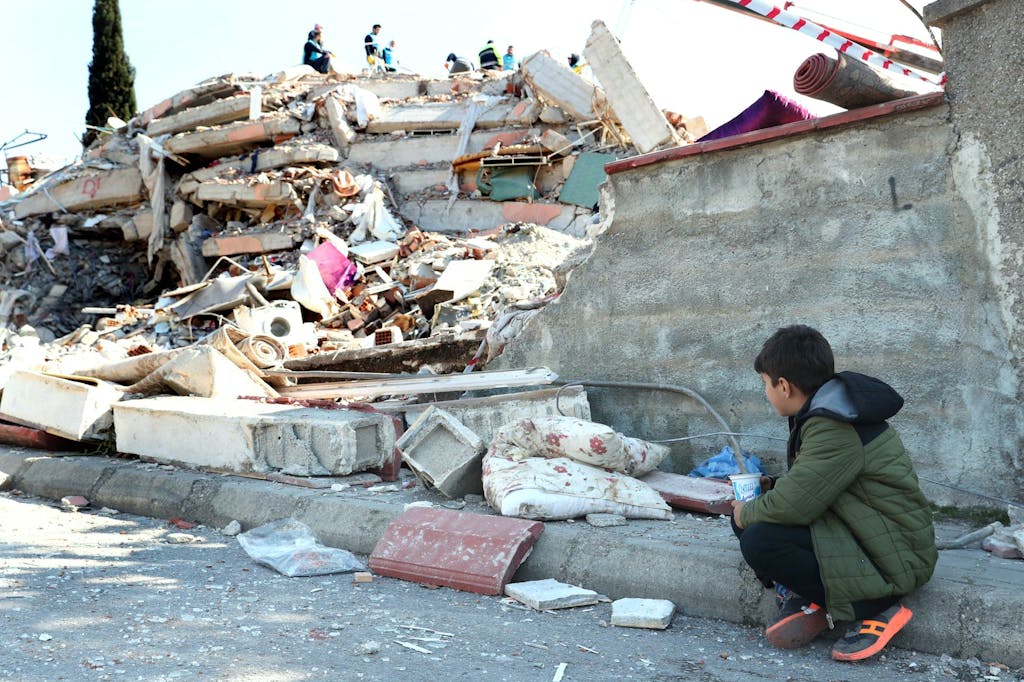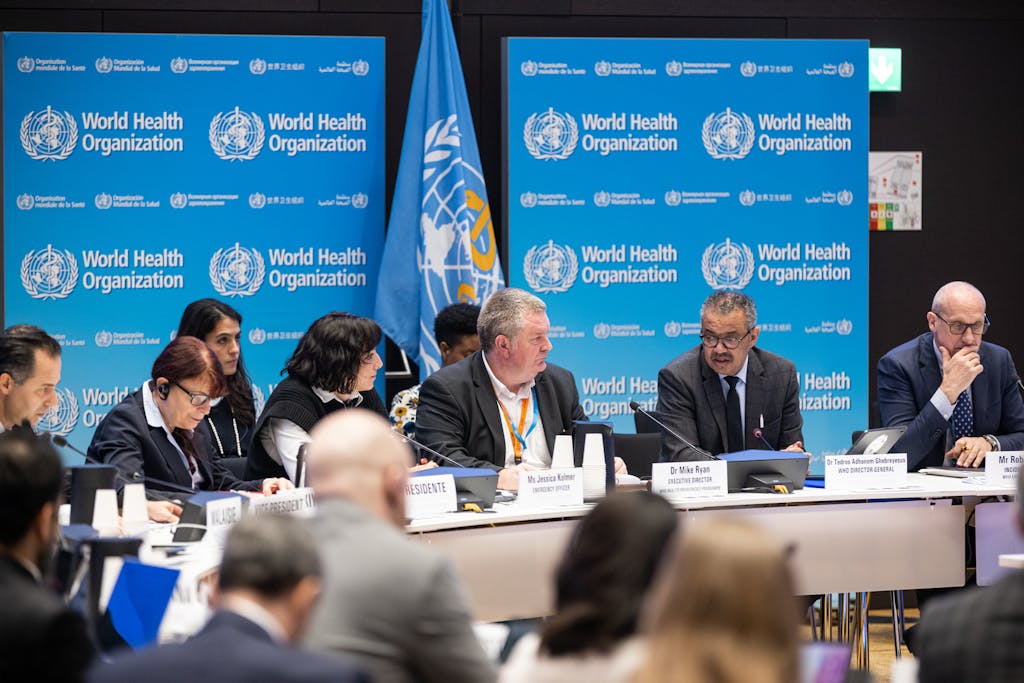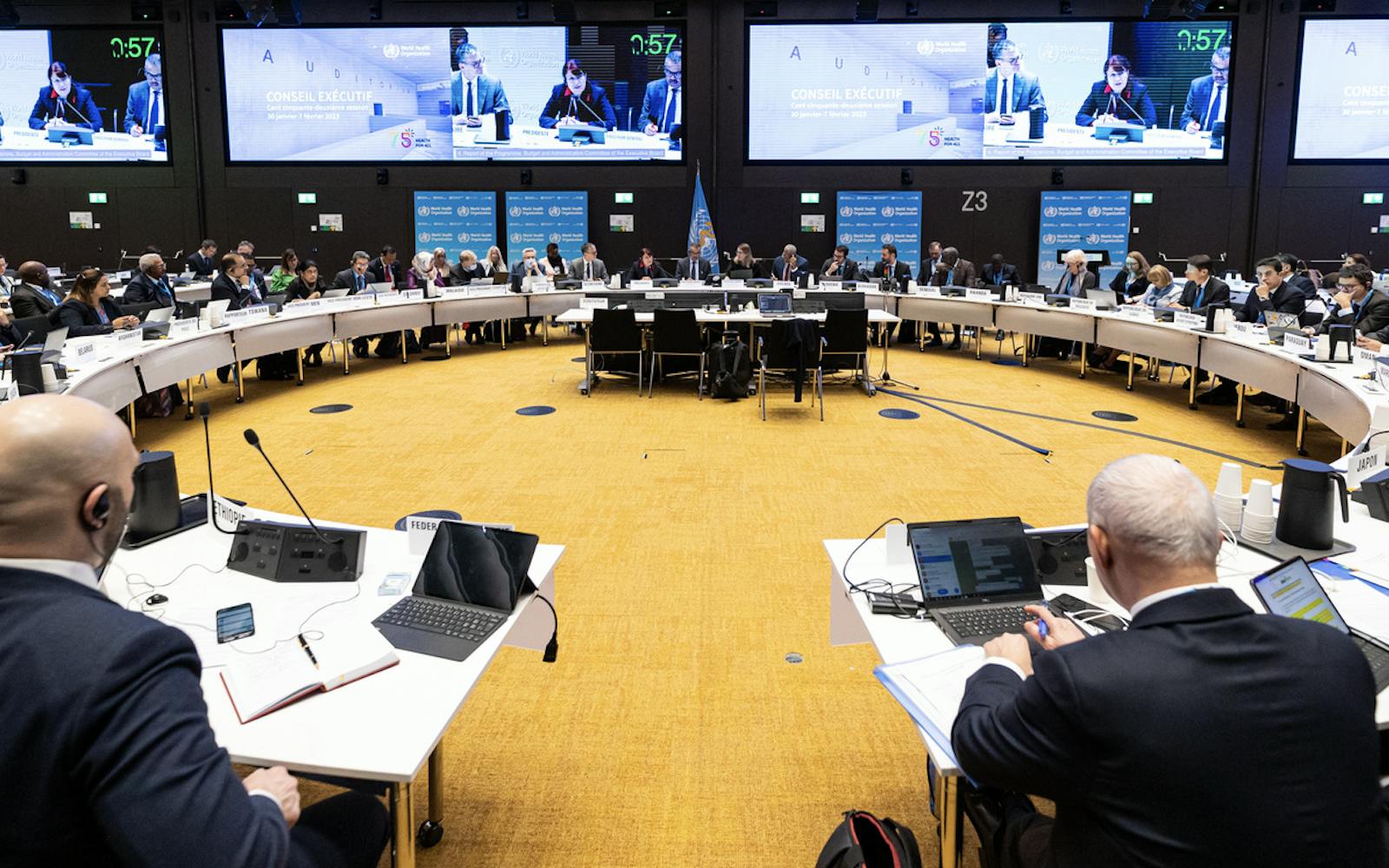The just-concluded 152nd session of the Executive Board of the World Health Organization covered a broad range of issues in the global health policy landscape. The agency’s work in health emergencies, including in Ukraine and now in Türkiye and Syria, took center stage as the curtain raised on what could be a watershed year for global health.
Each year in January, the Executive Board (EB) of the World Health Organization (WHO) meets to prepare for the annual World Health Assembly in May. The Board, which comprises a rotating group of 34 WHO Member States, sets the agenda and agrees on resolutions for consideration at the Assembly, where representatives of all 194 Member States gather. For this reason, EB meetings typically cover an expansive agenda.
At this year’s seven-day meeting, global preparedness for health emergencies, sustainable financing for WHO, and the health crisis resulting from the war in Ukraine all featured prominently. During the meeting, diplomats tussled over a report detailing the health situation in Ukraine. The report documented more than 14,000 civilian casualties and 448 attacks with heavy weapons on Ukrainian health care facilities.
The Russian Federation contested the report, contending that it was not objective. Other Member States also called for data in the report to be updated, since the figures were from October 2022. Dr. Tedros Adhanom Ghebreyesus, WHO’s Director-General, said the report was written “truthfully and in good faith.” The Secretariat assured that work would continue on the report with a view to providing “comprehensive, balanced, and validated data.”
Just as the board was wrapping up its deliberations, the earthquake struck in Türkiye and Syria, imperiling health and health care there. WHO quickly established incident management teams in the affected areas and is activating its network of emergency medical teams to provide care for people who were critically injured.
“We will work closely with all partners to support authorities in both countries in the critical hours and days ahead, and in the months and years to come, as both countries recover and rebuild,” Dr. Tedros said.
These unexpected developments, together with the planned EB agenda, effectively raised the curtain on the 2023 global health policy agenda. This year, countries are set to engage in key negotiations on a new pandemic accord and amendments to the International Health Regulations (IHR). They are also expected to hold seminal meetings in New York in September on universal health coverage and pandemic preparedness, response, and resilience. With these high-stakes moments across the calendar and robust discussion kicking off at the EB level, 2023 could very well become a watershed year for global cooperation on health.

Nine-year-old Berat waits for his friend to be rescued from under the debris in Kahramanmaraş after the Türkiye-Syria earthquake on February 6, 2023.
Photo: Fatih Isci/UNICEF
Strengthening the architecture for health emergency preparedness, response, and resilience
Given the vigorous global discourse about how to best prepare for the next pandemic, one of the most intensely anticipated discussions at the EB meeting was related to WHO’s 10 proposals for strengthening the global architecture for health emergency preparedness, response, and resilience. The proposals are distilled from more than 300 recommendations that emerged from several independent evaluations of the global response to the COVID-19 pandemic. Together, the proposals provide a vision for how various pandemic preparedness initiatives could interrelate in one comprehensive framework.
The proposals reflect ongoing efforts, such as the negotiation of the pandemic accord and IHR amendments. New proposals are also in the package, among them an end-to-end logistics supply chain for health emergencies and a new high-level global health emergencies council to govern future health emergencies under the aegis of WHO.
The 10 proposals were introduced last year, and the EB meeting was the first opportunity for Member States to share their views on the record. They supported certain aspects of the health emergency preparedness, response, and resilience plan, especially the IHR amendment and pandemic accord negotiations, which they see as the primary channels for strengthening the norms of global governance for health emergencies. Member States are highly invested in these negotiations because they are the most politically viable pathways to create game-changing policies that bring about more equitable and effective responses to future health emergencies. They were also interested in the proposals for the logistics supply chain and for a new peer review process for Member States to evaluate each other’s pandemic readiness capacities.
Other proposals were less warmly received, including the idea for a global health emergency council based at WHO and for a new governance committee on health emergencies within the EB. Many Member States generally thought it was premature to discuss such ideas and warned that creating these new bodies might only further fragment the global health ecosystem.
Although the health emergency preparedness, response, and resilience plan was met with mixed reviews, Member States agreed that the Secretariat should continue developing the proposals for discussion among all Member States at WHA in May.
Recognition for primary health care and the health workforce
An area of work that is enjoying broad support from Member States is universal health coverage (UHC). With a high-level meeting on UHC taking place at the UN General Assembly in September, the EB meeting set the stage for primary health care to be the star of the show. The necessity of a trained and capacitated health workforce also continues to crystallize as a policy priority for the UHC agenda. Member States emphasized that stronger primary health care delivery and a robust health workforce were force multipliers that could jointly serve UHC and pandemic preparedness, response, and resilience goals and the Sustainable Development Goals writ large. The adoption of a decision on preparation for the high-level meeting of the UN General Assembly on universal health coverage paves the way for a big UHC calendar moment in September. In addition to primary health care and a health workforce, key issues include:
- Prioritizing fiscal space for health through political leadership.
- Ensuring universal access to sexual and reproductive health care services, including for family planning.
- Integrating essential public health functions into primary health care, including surveillance and outbreak control, and supporting a One Health approach.
- Ensuring synergies among the three meetings on health during the UN General Assembly in 2023 and promoting coherent, integrated, and action-oriented global health agendas.

A briefing on the margins of the WHO Executive Board meeting covered the situation in Türkiye and Syria after a devastating earthquake and multiple aftershocks hit the regions on February 6, 2023. Photo: Pierre Albouy/WHO
Financing the Future of WHO
Another important discussion in the EB meeting concerned Member States’ ongoing effort to improve WHO’s financing structure. The 194 member governments of WHO have long recognized that the organization’s financing is insufficient and unsustainable to carry out its mandate. The COVID-19 pandemic spurred urgent action on the issue when WHO was thrust into the global spotlight and the world realized the critical importance of its coordinating function.
Since 2021, Member States have been negotiating a plan to refresh WHO’s financial flows, primarily by changing the conditions under which funding is provided by Member States rather than simply increasing the size of the budget. In a landmark decision last year, Member States agreed to begin moving away from unpredictable and heavily earmarked voluntary contributions and to slowly increase the proportion of the base budget that is funded by assessed contributions (membership dues). This year at WHA, Member States will be expected to make the first incremental increase (20%) in assessed contributions. The EB meeting mostly featured positive and affirming comments about this step, but the challenging fiscal environment globally left some governments questioning their earlier commitments.
A replenishment model was discussed as a second strategy to improve the sustainability of WHO’s financing. The intent of a WHO replenishment is for Member States to commit their voluntary contributions to WHO at the beginning of each new General Programme of Work (WHO’s multiyear strategy), which would improve the predictability and possibly the flexibility of those resources. At the EB meeting, Member States expressed wide support for the approach and agreed to move forward with discussions at WHA in May.
2023 Look Ahead
As the first forum for intergovernmental policymaking on health each year, the Executive Board meeting often previews what’s to come in the months ahead. This year was no exception. With the COVID-19 pandemic waning, many reforms to the global health architecture are now well underway. Governments are wrestling this year with thorny issues on equity, financing, governance, and much more. At the same time, WHO faces a range of challenges in delivering the strongest possible performance amid growing need.
Highly charged geopolitical affairs, such as Russia’s war in Ukraine, are manifesting in global health diplomacy at WHO. Compounding crises, such as the earthquake in Türkiye and Syria, require WHO to respond in new and urgent ways. As the COVID-19 pandemic begins to move off center stage, it remains as important as ever that Member States empower WHO to carry out its mandate by sustainably financing the organization and reinforcing its authority to set global norms on health.





